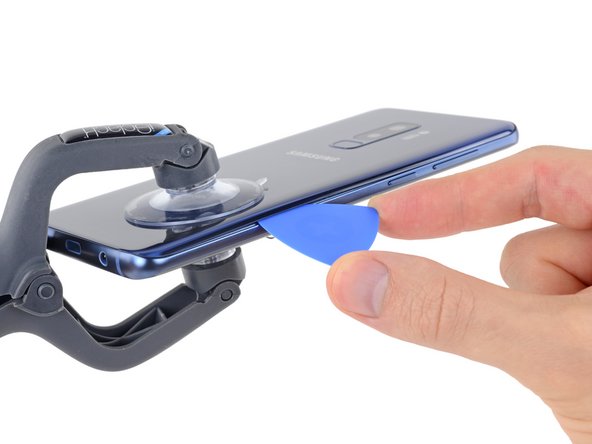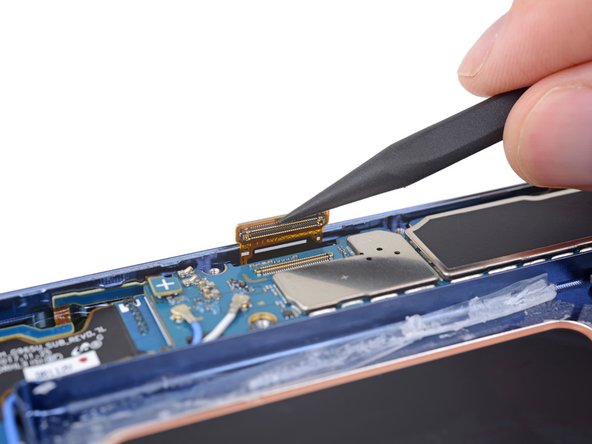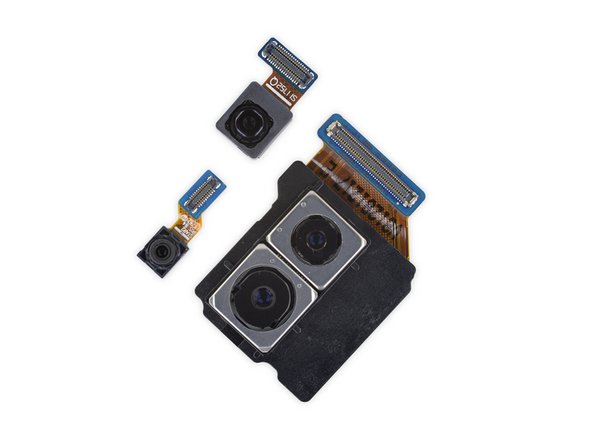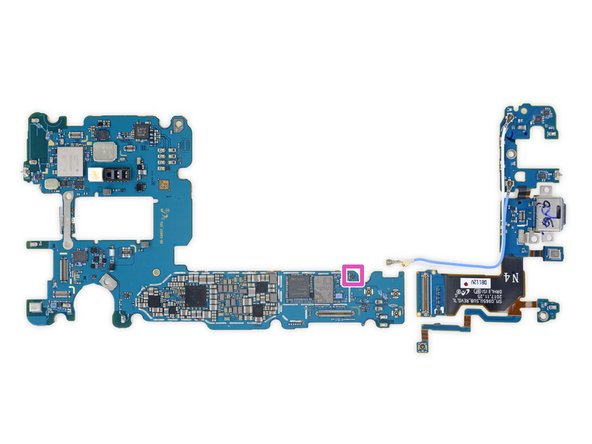Samsung Galaxy S9+ Teardown
Duration: 45 minutes
Steps: 19 Steps
Samsung doesn’t mess around with skipping numbers—here’s the Galaxy S9+, notch-free and ready to show off its insides. Is it a sleek powerhouse or just a fancy emoji generator? Only a teardown will reveal the truth. Want a peek inside the regular Galaxy S9? We’ve got that too. For more tech goodness and updates, catch us on Facebook, Twitter, and Instagram.
Step 1
- The S9+ is packing some serious specs and a variety of aperture sizes. Here’s the scoop:
- Notchless 6.2" AMOLED Display with a stunning resolution of 2960 × 1440 (~530 ppi)
- Qualcomm Snapdragon 845 or Samsung’s own Exynos 9810, depending on where you are in the world
- 12 MP OIS dual-aperture main camera—switch between f/1.5 and f/2.4 modes—plus a 12 MP OIS secondary camera and an 8 MP selfie cam for those perfect shots
- Headphone jack and microSD slot for all your audio and storage needs
- IP68 water and dust-proofing rating, so it can handle a little adventure
- Running on Android 8.0 Oreo for a smooth experience
Step 2
- Up top, you'll see the standard SIM slot along with a slightly shifted camera and fingerprint sensor combo. Say goodbye to fingerprint smudges on your lens! Down at the bottom, it looks almost identical to the S8—yes, that means the 3.5mm headphone jack is still hanging in there. At first glance, that tiny opening might look like a speaker grille replaced with a port, but nope—that's still a grille, with the mesh tucked way back. Wondering if speaker holes filled with lint are a thing? Not really. If you need help with this process, you can always schedule a repair.
If you thought the fake microphone hole on top was the only sneaky detail, think again—there's now a faux charging port to keep things interesting. It's like a tech hide-and-seek game, but don’t worry, with a little patience, you'll get it sorted. When in doubt, schedule a repair if things get tricky.
Step 3
- Samsung's keeping it classy with a notch-free look and impressively slim bezels, standing out among a crowd of iPhone-inspired designs.
- Flip it over, and while the iPhone X’s camera bump grabs attention, the S9+ goes for a wider sensor layout that's a little more chaotic in appearance.
- On display: S9+ rocking the left side, iPhone X showing off its 'bezel-less' notch game on the right.
- Glass backs are all the rage for wireless charging—awesome for convenience, but not so forgiving if you’re prone to drops.
- Back in the day, swapping the iPhone 4S’s glass back was a breeze in under two minutes; with these newer models, don’t expect an easy swap.
Step 4
You’ll notice that lots of newer phones like to tuck the battery away under layers of motherboard—kind of like a little cozy tech nest. But hey, there’s always that one phone out there doing its own thing!
- Before getting started, let's give a shoutout to our friends at Creative Electron for some high-energy recon to kick things off.
- Aside from a shiny new dual camera and a few minor component shuffles, everything here looks pretty much the same as the last time around. No surprises!
Step 5
- While it's not quite the S4, the S9 still offers a welcome break from some of the more recent, tricky teardowns. A little heat and a plastic opening tool go a long way, but be prepared—it's not exactly a smooth ride! Thanks to some experience (and a bit of luck), we can safely disconnect the sensor assembly cable without drama. Remember, detailed documentation makes everything easier. If you need a hand, you can always schedule a repair.
Step 6
The camera works some magic with its aperture, shifting to f/1.5 for those low-light moments—seriously, that's as wide as it gets in phone land. When things are bright, it snaps back to f/2.4 for crisp, sharp shots.
- After braving the tricky process of opening up the phone, we make our grand entrance to the back.
- Next stop: the rear camera, where we get to check out the slick new dual aperture setup.
- Most cameras use at least five blades to keep the aperture nice and round as it shifts through different f-stops. This Galaxy switches things up with just two rotating, ring-shaped blades for a quick adjustment.
Step 7
- First up, the relocated fingerprint sensor. It’s held in place with a sticky ring that keeps it safe from spills—time to gently pry it free.
- Pro tip: that fingerprint sensor cable loves to hide in glue under the back cover. Watch out, or you’ll end up with a sticky situation. Maybe next time Samsung will give us a break!
- After removing fifteen screws, the midframe pops out like a seasoned pro, bringing along the wireless charging coil, antenna assembly, and lower speaker for the ride.
Step 8
Here’s the power source: a 3.85 V, 3500 mAh battery with 13.48 Wh of juice. Look familiar?
- To loosen a glued-down battery in a Galaxy phone, you have a couple of options. First, you can carefully apply some heat with a heat gun or a specialized tool, then gently pry the battery free using a plastic pry tool—just be ready with a fire extinguisher, a bucket of sand, and nerves of steel. Alternatively, for a gentler approach, load a syringe with some Adhesive Remover and carefully apply it around the edges to dissolve the glue. Keep in mind, Samsung often uses a sticky black webbing on top of their batteries—no clear idea why, but if you’ve got insights, shout out! If you need help with this process, you can always schedule a repair to get it done professionally.
Tools Used
Step 9
- Let’s set the motherboard free: just remove two screws and pop off a couple FPC connectors with your trusty spudger.
- Surprise! The display cable is sneakily threaded through a narrow opening in the chassis and locked onto the motherboard, as if clinging for dear life...
- Motherboard: officially liberated.
- ...But if you’ve checked out any Galaxy teardowns lately, you probably saw this move coming.
- Samsung, we get the reasoning, but surely you can give us a display that’s easier to disconnect and swap out—without prying off a glued cover. Challenge accepted?
Tools Used
Step 10
If you’re keeping score, you might be tempted to say this device packs five cameras—thanks to the dual-aperture setup. Technically, it’s rocking four image sensors, but you get five different ways to snap a photo. Pretty cool, right?
- Even though we've got dual image sensors, this double camera is actually a single unit, all snug on one PCB with just one connector!
- The S9+ camera lineup is now a total of four—along with the shiny new dual main camera, we've got the selfie and iris cameras joining the party.
- This time around, it looks like the camera series is dubbed 'Star', a fun twist from last year's 'Dream' cameras.
- Our pals at TechInsights took a peek inside the camera modules, and guess what? There are chips hiding in there! Samsung boasts that their integrated DRAM lets the camera handle up to four times more image data. How about some 960 FPS slow-mo action?
Step 11
Good news! The charging port lives on a daughterboard, not the motherboard, which means swapping it out is way easier (and easier on your wallet). Samsung, you actually made this one simple!
- The headphone jack makes a handy comeback here. Its gasket keeps your phone protected, and since it’s modular, replacing it is a straightforward, budget-friendly task if needed. Next, we grab the versatile daughterboard assembly, which includes coaxial cables, microphone, USB-C port, and plenty of spring contacts—think of it as the control center of the device. Then, we move on to the second speaker—the earpiece—which now also functions as a loudspeaker, giving you that nice stereo or even 'surround sound' experience that modern phones can deliver. If you need help, you can always schedule a repair.
Step 12
- Lay out that motherboard and take a look! On Side A, you’ll spot all the main players:
- Samsung K3UH6H60AM-NGCJ LPDDR4X 6 GB DRAM sitting on top of the Qualcomm Snapdragon 845
- Toshiba THGAF4G9N4LBAIR 64 GB UFS (NAND flash plus controller)
- Avago AFEM-9096 front end module
- Qualcomm Aqstic™ WCD9341 audio codec
- Maxim Integrated MAX77705F PMIC
- Qualcomm QET4100 envelope tracker
- Maxim MAX98512 audio amplifier
Step 13
- Side B packs a punch with all the components that didn’t make it onto Side A. Here’s what you’ll find: the Murata KM7N16048 Wi-Fi/Bluetooth module, the NXP PN80T NFC controller, the Qualcomm PM845 (probably a PMIC), the Qualcomm SDR845 RF transceiver, the Skyworks SKY78160-11 WLAN front-end module, the Qualcomm PM8005 power management IC, and the Skyworks SKY13716-1 low band front-end module. Take your time to identify and handle each part carefully—these are the key players in keeping your device connected and powered up. If you need help, you can always schedule a repair.
Step 14
- IC Identification, pt. 2:
- Meet the Qualcomm QDM3870—your high-band diversity front-end module, keeping things speedy.
- The Qualcomm D5319 is here for your mid-band diversity duties.
- RDA Microelectronics RDA6213N FM transceiver—probably the one making your tunes play.
- Samsung S2MPB02—camera's power boss.
- Samsung S2DOS05—display's power manager.
- Samsung S2MPB03—camera power management, part two.
- Renesas (used to be IDT) P9320S—your wireless charging receiver.
Step 15
- IC Identification, pt.3:
- Meet the NXP PCAL6524—your 24-bit I/O expander for all those extra signals.
- Here's the ON Semiconductor FPF3688UCX, running the show as a load switch.
- Spot the Texas Instruments boost converter (very likely), kicking voltage up a notch.
- Another ON Semiconductor star: FAN48618BUC53X 1A boost regulator for a bit of extra power.
- Vishay DG2730: 2-port, 480 Mbps USB 2.0 DPDT analog switch—keeping your connections snappy.
- Richtek RT8010GQW 1A step-down DC-DC converter, dropping voltage like it’s hot.
- Texas Instruments TPS7A05 200mA LDO regulator, smoothing things out at the end.
Step 16
- Sensor Showdown, pt. 4:
- Meet the STMicroelectronics LSM6DSL – your phone’s motion maestro, handling all things accelerometer and gyroscope.
- Say hi to the AKM Semiconductor AK09916C, the compass that keeps your directions on point.
- Next up: STMicroelectronics LPS22HB. This pressure sensor is the air whisperer, keeping tabs on altitude.
- Heart rate sensor – your phone’s personal fitness coach.
- Ablic S-5712CCDL1-I4T1U hall sensor is here for magnetic moves.
- And the Semtech SX9320 proximity sensor (probably) – keeping your screen off when your face is up close.
Step 17
- Getting into the display teardown is a bit of a tug-of-war—lots of heat and patience needed. The glue can be stubborn, so instead of fighting it with a bunch of iOpeners, grab a heat gun to warm things up and make the process smoother. When replacing a broken screen, it’s a bit of a marathon, but with steady effort, you'll get there. The display cable, made by Samsung and often labeled 'Star', combines both the display and digitizer in a sealed unit, so handle it carefully. You'll also find two final chips attached to the display: the Samsung S6SY761X touch controller, which you might recognize from the S8 series, and the Winbond W25Q80EWUXIE 8 Mb serial NOR flash. If at any point you need a hand or want to get the job done professionally, you can always schedule a repair with Salvation Repair.
Tools Used
Step 18
- Time to get up close and personal with the biometrics!
- On the left, we've got the trusty S9+ hardware: iris scanner, front-facing camera, IR emitter, and proximity sensor (probably that AMS TMD4906). Looks like a familiar face from last year, doesn't it?
- On the right, meet the heart of Apple's notch: Face ID hardware. This includes a front-facing camera, IR dot projector, IR camera, plus space for the flood illuminator and rangefinder, all tucked neatly into the display.
- Some assembly required—don't worry, it's nothing you can't handle.
- Early reviews are in, and it seems like Samsung might've gotten a little too excited about Animoji without a hardware refresh to keep up. But hey, we all get a little ahead of ourselves sometimes.
Step 19
Want to be the first to hear about our latest teardown updates? Join our press list and get the scoop before anyone else!
- All done! Check out the Galaxy S9+ parts you’ve just uncovered. If you hit a snag or want a pro touch, you can always schedule a repair.





















































